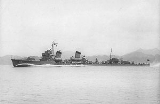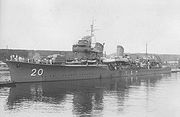
Japanese destroyer Sagiri
Encyclopedia
{|
|}


 was the sixteenth of twenty-four destroyer
was the sixteenth of twenty-four destroyer
s, built for the Imperial Japanese Navy
following World War I
. When introduced into service, these ships were the most powerful destroyers in the world. They served as first-line destroyers through the 1930s, and remained formidable weapons systems well into the Pacific War
.
s in other navies. Sagiri, built at the Uraga Dock Company
was the sixth in an improved series, which incorporated a modified gun turret
which could elevate her main battery of Type 3 127 mm 50 caliber naval guns to 75° as opposed to the original 40°, thus permitting the guns to be used as dual purpose gun
s against aircraft. Sagiri was laid down on March 28, 1929, launched on December 23, 1929 and commissioned on January 31, 1930. Originally assigned hull designation "Destroyer No. 50", she was commissioned as Sagiri.
The 4th Fleet Incident
occurred only a year after her commissioning, and Sagiri was quickly taken back to the shipyards for strengthening of her hull.
. During the Second Sino-Japanese War
, from 1937, Sagiri covered landing of Japanese forces in Shanghai
and Hangzhou
. From 1940, she was assigned to patrol and cover landings of Japanese forces in south China.
, Sagiri was assigned to Destroyer Division 20 of Desron 3 of the IJN 1st Fleet
, and had deployed from Kure Naval District
to the port of Samah on Hainan
Island.
From 17 December, Sagiri covered Japanese landings at Miri
and at Kuching
in Sarawak
. On 24 December 1941, approximately 35 nautical miles (64.8 km) off Kuching, Sagiri was torpedoed by the Dutch submarine K XVI. Her aft magazine
caught fire and exploded, sinking the ship at position 01°34′N 110°21′E with the loss of 121 of her crew. Some 120 survivors were rescued by her sister ship
, Shirakumo
.
On 15 January 1942, Sagiri was removed from the navy list
.
|}



Destroyer
In naval terminology, a destroyer is a fast and maneuverable yet long-endurance warship intended to escort larger vessels in a fleet, convoy or battle group and defend them against smaller, powerful, short-range attackers. Destroyers, originally called torpedo-boat destroyers in 1892, evolved from...
s, built for the Imperial Japanese Navy
Imperial Japanese Navy
The Imperial Japanese Navy was the navy of the Empire of Japan from 1869 until 1947, when it was dissolved following Japan's constitutional renunciation of the use of force as a means of settling international disputes...
following World War I
World War I
World War I , which was predominantly called the World War or the Great War from its occurrence until 1939, and the First World War or World War I thereafter, was a major war centred in Europe that began on 28 July 1914 and lasted until 11 November 1918...
. When introduced into service, these ships were the most powerful destroyers in the world. They served as first-line destroyers through the 1930s, and remained formidable weapons systems well into the Pacific War
Pacific War
The Pacific War, also sometimes called the Asia-Pacific War refers broadly to the parts of World War II that took place in the Pacific Ocean, its islands, and in East Asia, then called the Far East...
.
History
Construction of the advanced Fubuki-class destroyers was authorized as part of the Imperial Japanese Navy's expansion program from fiscal 1923, intended to give Japan a qualitative edge with the world's most modern ships. The Fubuki-class had performance that was a quantum leap over previous destroyer designs, so much so that they were designated . The large size, powerful engines, high speed, large radius of action and unprecedented armament gave these destroyers the firepower similar to many light cruiserLight cruiser
A light cruiser is a type of small- or medium-sized warship. The term is a shortening of the phrase "light armored cruiser", describing a small ship that carried armor in the same way as an armored cruiser: a protective belt and deck...
s in other navies. Sagiri, built at the Uraga Dock Company
Uraga Dock Company
was a major privately owned shipyard in Uraga, Japan, which built numerous warships for the Imperial Japanese Navy.-History:Uraga Dock Company was founded by Enomoto Takeaki in 1869. A shipyard had already existed in Uraga from the end of the Edo period...
was the sixth in an improved series, which incorporated a modified gun turret
Gun turret
A gun turret is a weapon mount that protects the crew or mechanism of a projectile-firing weapon and at the same time lets the weapon be aimed and fired in many directions.The turret is also a rotating weapon platform...
which could elevate her main battery of Type 3 127 mm 50 caliber naval guns to 75° as opposed to the original 40°, thus permitting the guns to be used as dual purpose gun
Dual purpose gun
A dual purpose gun is a naval artillery mounting designed to engage both surface and air targets.-Description:Second World War-era capital ships had four classes of artillery: the heavy main battery, intended to engage opposing battleships and cruisers ; a secondary battery for use against enemy...
s against aircraft. Sagiri was laid down on March 28, 1929, launched on December 23, 1929 and commissioned on January 31, 1930. Originally assigned hull designation "Destroyer No. 50", she was commissioned as Sagiri.
The 4th Fleet Incident
IJN 4th Fleet
The was a fleet designation of the Imperial Japanese Navy. The Fourth Fleet designation was used during three separate periods. The initial designation was for a group of ships that were assigned to work together during the Russo-Japanese conflict and the period of its immediate aftermath...
occurred only a year after her commissioning, and Sagiri was quickly taken back to the shipyards for strengthening of her hull.
Operational history
On completion, Sagiri was assigned to Destroyer Division 20 under the IJN 2nd FleetIJN 2nd Fleet
The was a fleet of the Imperial Japanese Navy.-History:First established on 28 December 1903, the IJN 2nd Fleet was created by the Imperial General Headquarters as a mobile strike force of cruisers and destroyers to pursue the Imperial Russian Navy's Vladivostok-based cruiser squadron while the...
. During the Second Sino-Japanese War
Second Sino-Japanese War
The Second Sino-Japanese War was a military conflict fought primarily between the Republic of China and the Empire of Japan. From 1937 to 1941, China fought Japan with some economic help from Germany , the Soviet Union and the United States...
, from 1937, Sagiri covered landing of Japanese forces in Shanghai
Shanghai
Shanghai is the largest city by population in China and the largest city proper in the world. It is one of the four province-level municipalities in the People's Republic of China, with a total population of over 23 million as of 2010...
and Hangzhou
Hangzhou
Hangzhou , formerly transliterated as Hangchow, is the capital and largest city of Zhejiang Province in Eastern China. Governed as a sub-provincial city, and as of 2010, its entire administrative division or prefecture had a registered population of 8.7 million people...
. From 1940, she was assigned to patrol and cover landings of Japanese forces in south China.
World War II history
At the time of the attack on Pearl HarborAttack on Pearl Harbor
The attack on Pearl Harbor was a surprise military strike conducted by the Imperial Japanese Navy against the United States naval base at Pearl Harbor, Hawaii, on the morning of December 7, 1941...
, Sagiri was assigned to Destroyer Division 20 of Desron 3 of the IJN 1st Fleet
IJN 1st Fleet
The was the main battleship fleet of the Imperial Japanese Navy.-History:First established on 28 December 1903, the IJN 1st Fleet was created during the Russo-Japanese War when the Imperial General Headquarters divided the Readiness Fleet into a mobile strike force of cruisers and destroyers to...
, and had deployed from Kure Naval District
Kure Naval District
was the second of four main administrative districts of the pre-war Imperial Japanese Navy. Its territory included the Inland Sea of Japan and the Pacific coasts of southern Honshū from Wakayama to Yamaguchi prefectures, eastern and northern Kyūshū and Shikoku....
to the port of Samah on Hainan
Hainan
Hainan is the smallest province of the People's Republic of China . Although the province comprises some two hundred islands scattered among three archipelagos off the southern coast, of its land mass is Hainan Island , from which the province takes its name...
Island.
From 17 December, Sagiri covered Japanese landings at Miri
Miri
Miri is a city in northern Sarawak, Malaysia, on the island of Borneo. It is the second largest city in Sarawak, with a population of about 300,000, and the government administrative centre of Miri District in Miri Division....
and at Kuching
Kuching
Kuching , officially the City of Kuching, and formerly the City of Sarawak, is the capital and most populous city of the East Malaysian state of Sarawak. It is the largest city on the island of Borneo, and the fourth largest city in Malaysia....
in Sarawak
Kingdom of Sarawak
The Kingdom of Sarawak was a state in Borneo established by Sir James Brooke in 1842 by receiving independent kingdom status from the Sultanate of Brunei as a reward for helping fight piracy and insurgency...
. On 24 December 1941, approximately 35 nautical miles (64.8 km) off Kuching, Sagiri was torpedoed by the Dutch submarine K XVI. Her aft magazine
Magazine (artillery)
Magazine is the name for an item or place within which ammunition is stored. It is taken from the Arabic word "makahazin" meaning "warehouse".-Ammunition storage areas:...
caught fire and exploded, sinking the ship at position 01°34′N 110°21′E with the loss of 121 of her crew. Some 120 survivors were rescued by her sister ship
Sister ship
A sister ship is a ship of the same class as, or of virtually identical design to, another ship. Such vessels share a near-identical hull and superstructure layout, similar displacement, and roughly comparable features and equipment...
, Shirakumo
Japanese destroyer Shirakumo
was a destroyer and the eighth in a class of twenty-four vessels built for the Imperial Japanese Navy following World War I. When introduced into service, these ships were the most powerful destroyers in the world...
.
On 15 January 1942, Sagiri was removed from the navy list
Navy List
A Navy List or Naval Register is an official list of naval officers, their ranks and seniority, the ships which they command or to which they are appointed, etc., that is published by the government or naval authorities of a country....
.

